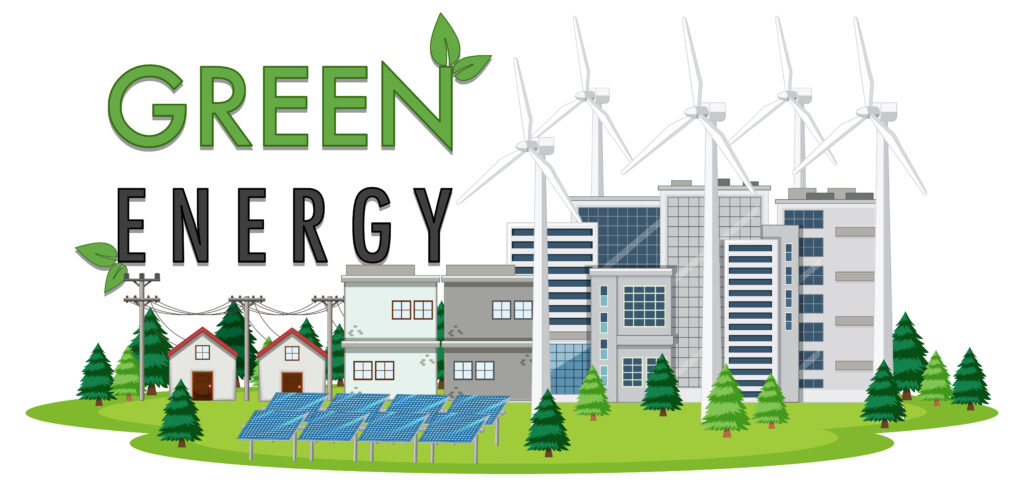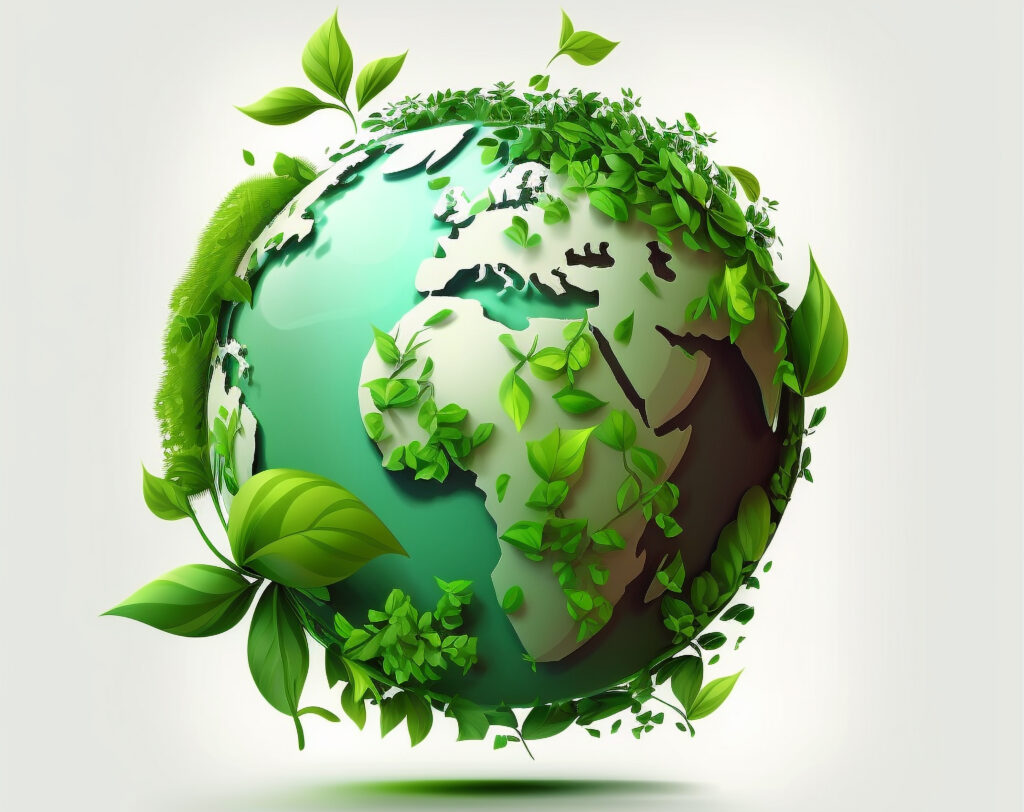What is Green Energy?
Green energy, often referred to as clean, sustainable, or renewable energy, is energy harnessed from sources that naturally replenish themselves. Unlike conventional energy generation, green energy doesn’t release harmful greenhouse gases into the atmosphere, making it an environmentally friendly choice. Key sources of green energy include solar power, wind energy, geothermal resources, biogas, low-impact hydroelectricity, and specific types of biomasses.
What is the difference between Green Energy and Renewable Energy?
Green energy is defined as energy that can be produced in a way and from a source that does not harm the natural environment. The terms ‘green energy’ and ‘ renewable energy’ are sometimes used interchangeably, but there is an important distinction between them. While the majority of green energy sources are also renewable, not all renewable energy sources are completely green.
Renewable energy sources, such as wind and solar power, are constantly and organically renewed. Renewable energy is sometimes referred to as sustainable energy. A renewable energy source may not be called ‘green’ if some carbon emissions are involved with the procedures needed to create the energy, such as infrastructure construction.
Why is there a need to shift to Green Energy?
Climate change poses a serious threat to the course of human history, and India plays a significant role in this issue as the third-largest global energy consumer. Since the year 2000, energy consumption in India has been on the rise, primarily reliant on coal, oil, and solid biomass, accounting for 80% of the total energy demand. These conventional energy sources, known as fossil fuels, are the primary contributors to climate change, responsible for approximately 90% of carbon dioxide emissions and over 75% of global greenhouse gas emissions.
To pave the way for a brighter future and align with India’s goal of achieving net-zero emissions by 2070, the adoption of green energy is crucial. India has the potential to take a leading role in creating a new economic growth model that breaks away from carbon-heavy strategies previously used by many nations. This transformation could serve as an example for other developing economies seeking to transition to cleaner energy sources.
Benefits of Switching to Green Energy
- Reduction of Greenhouse Gas Emissions: India is one of the world’s largest emitters of greenhouse gases. By transitioning to renewable energy sources like solar and wind power, the country can significantly reduce its carbon footprint. This reduction is essential to combat climate change and fulfill India’s commitments under the Paris Agreement.
- Reduction in Water Consumption: Many traditional power generation methods, such as coal and natural gas plants, require large amounts of water for cooling. In a country like India, where water scarcity is a pressing issue, shifting to renewable energy sources, which require little to no water, is an essential step in conserving this valuable resource.
- Energy Diversification: A diverse energy mix, including renewables, enhances energy resilience. In cases of fuel shortages or natural disasters, green energy sources like wind and solar continue to produce electricity, reducing the risk of blackouts and ensuring a reliable energy supply.
- Improved Air Quality: Air pollution is a major public health concern in many Indian cities. Fossil fuel combustion, especially in the transportation and energy sectors, is a major contributor to air pollution. Green energy sources produce little to no air pollutants, which can lead to cleaner air and a reduction in respiratory diseases.
- Energy Security: India’s heavy reliance on imported fossil fuels, such as oil and natural gas, makes its energy sector vulnerable to global market fluctuations and geopolitical tensions. Investing in domestic green energy sources like solar and wind reduces this dependency and enhances energy security.
- Economic Growth: The green energy sector attracts investments from both public and private sectors. These investments can stimulate economic growth by creating demand for goods and services related to renewable energy, including manufacturing, construction, and research and development.
Current Situation of Green Energy in India
According to the REN21 Renewables 2022 Global Status Report, India ranks fourth in the world in Renewable Energy Installed Capacity (including Large Hydro), fourth in Wind Power capacity, and fourth in Solar Power capacity. At COP26, the country increased its ambition to 500 GW of non-fossil fuel-based energy by 2030. This is an important promise under the Panchamrit. This is the world’s largest renewable energy expansion plan.
In the last 8.5 years, India’s installed non-fossil fuel capacity has expanded 396% to more over 179.322 Giga Watts (including big hydro and nuclear), accounting for approximately 43% of total capacity (as of July 2023). In 2022, India had the biggest year-on-year growth in renewable energy additions, at 9.83%. In the last nine years, installed solar energy capacity has expanded by 24.4 times, reaching 67.07 GW in July 2023. Since 2014, installed renewable energy capacity (including large hydro) has expanded by around 128%.
Under the automatic route, renewable energy generating, and distribution projects can get up to 100% FDI, subject to the rules of The Electricity Act 2003. As of July 2023, Renewable energy sources, including large hydropower, have a combined installed capacity of 179.322 GW.

The following is the installed capacity for Renewables:
- Wind power: 42.8 GW
- Solar Power: 67.07 GW
- Biomass/Co-generation: 10.2 GW
- Small Hydro Power: 4.94 GW
- Waste To Energy: 0.55 GW
- Large Hydro: 46.85 GW
India’s Initiative Towards Green Energy
The Indian Government has taken several steps to promote renewable energy, including wind energy, in the country. These include:
- Permitting Foreign Direct Investment (FDI) up to 100 percent under the automatic route,
- Waiver of Inter-State Transmission System (ISTS) charges for inter-state sale of solar and wind power for projects to be commissioned by 30th June 2025,
- Declaration of trajectory for Renewable Purchase Obligation (RPO) up to the year 2022,
- Setting up of Ultra Mega Renewable Energy Parks to provide land and transmission to RE developers on a plug-and-play basis,
- Laying of new transmission lines and creating new sub-station capacity for evacuation of renewable power,
- Setting up of Project Development Cell for attracting and facilitating investments,
- Standard Bidding Guidelines for tariff-based competitive bidding process for procurement of Power from Grid Connected Solar PV and Wind Projects.
- The government has issued orders that power shall be dispatched against a Letter of Credit (LC) or advance payment to ensure timely payment by distribution licensees to RE generators.
- Conducting skill development programs to create a pool of skilled manpower for the implementation, operation, and maintenance of RE projects.
In addition to the above, the following steps have been taken specifically for promoting wind energy:
- Concessional custom duty exemption on certain components required for manufacturing of wind electric generators.
- Generation Based Incentive (GBI) is being provided to the wind projects commissioned on or before 31 March 2017.
- Technical support including wind resource assessment and identification of potential sites through the National Institute of Wind Energy, Chennai.
The Future of India in terms of Green Energy
India has set a target to reduce the carbon intensity of the nation’s economy by less than 45% by the end of the decade, achieve 50 percent cumulative electric power installed by 2030 from renewables, and achieve net-zero carbon emissions by 2070. India aims for 500 GW of renewable energy installed capacity by 2030.
India aims to produce five million tonnes of green hydrogen by 2030. This will be supported by 125 GW of renewable energy capacity.
57 solar parks with an aggregate capacity of 39.28 GW have been approved in India. Wind Energy has an offshore target of 30 GW by 2030, with potential sites identified.
Challenges Faced While Developing the Energy Sector in India
Access to energy is a severe issue in India, with significant discrepancies. In India, around 77 million families continue to use kerosene for lighting. Rural India, where up to 44% of households lack access to electricity, exacerbates the situation. While India has initiated a variety of programs and initiatives to combat energy poverty, they have run into logistical difficulties and inadequate local implementation.
India’s crude oil import bill jumped by 76% to USD 90.3 billion in the first half of 2022-23, while overall imports increased by 15%. India’s energy security is under threat due to its increasing reliance on imported oil, and the current disrupted global supply chain caused by geopolitical turbulence is worsening the problem.
In terms of renewable energy, India also strongly relies on other countries for solar modules, such as China. Backward integration in the solar value chain is weak since India currently lacks manufacturing capacity for solar wafers and polysilicon, slowing the transition to sustainable energy.
Climate change affects fuel availability, energy consumption, and the physical longevity of current and future energy infrastructure. Climate change-induced heatwaves and disrupted monsoons are already putting a strain on existing energy output, making it even more vital to reduce fossil fuel emissions.
According to Ministry of Coal data for 2021, the gap between demand and domestic supply of coal is widening. Despite huge reserves, coal output in the major coal-producing states has been declining. Rising rates and unresolved contractual issues with power plants are worsening the situation.
Opportunities in the Renewable Energy Sector of India
India is an excellent destination for investments in renewable energy. Since 2014, more than $78 billion has been invested in India’s renewable energy sector. Abundant labor, easy access to low funding, and single-window permissions make India an appealing location for renewable energy plant development. Long-term power purchase agreements at set rates, as well as a strong grid link, determine the returns on investment in Inda. Renewable energy projects worth $ 197 billion are now under construction in India. Furthermore, numerous Indian governments have established their particular renewable energy targets, bolstering the possibility for favorable returns even further.
The recently announced ‘Green Hydrogen Mission’, worth $ 2.4 billion, intends to reach at least 5 MMT (million metric tons) of green hydrogen production capacity per year, as well as 60 GW of electrolyzer capacity, by 2030 – and to position India as a market leader in green hydrogen adoption. Financial incentives of $ 2.12 billion are also being offered under the Strategic Interventions for Green Hydrogen Transition Programme (SIGHT) for both green hydrogen production and electrolyzer manufacturing.
